Table of Contents
Exposed: How Formaldehyde in Makeup May Be Harming You
This page may contain affiliate links. We may earn a commission on purchases, at no additional cost to you. Learn more →
Did you know that around 20% of all cosmetic products contain formaldehyde and formaldehyde releasers? Yep, everything from nail polishes to shampoos relies on this controversial ingredient. While it is great for preserving products, formaldehyde in makeup has raised some serious questions about its safety and impact on our health.
For the longest time, formaldehyde flew under my radar. I never really thought about it until I started paying closer attention to ingredient lists on my favourite beauty products. I began to understand why so many people worry about hidden chemicals in makeup.
Is formaldehyde as bad as they say it is? Sure, this ingredient helps extend shelf life, but at what cost to our health?
Let's talk about what formaldehyde is, why it's used, the risks it poses and most importantly - how to find safer, formaldehyde-free options.
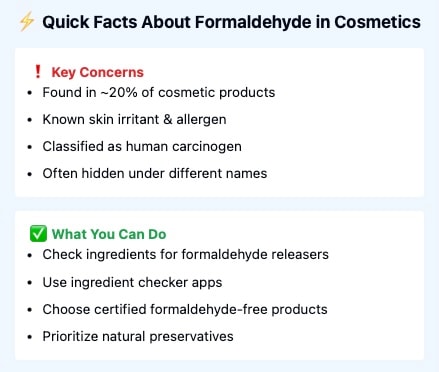
What is Formaldehyde?
Formaldehyde is a colorless, strong-smelling gas that is naturally present in our environment, and it has been around for centuries. Formaldehyde was first used as an embalming agent or medical preservative in the mid-19th century.
Nowadays, nearly two-thirds of formaldehyde is now used in everyday products like construction materials, adhesives, and, yes, cosmetics.
I didn’t think much about it until I started researching the ingredients that go on my skin every day.
How is Formaldehyde and Formaldehyde Releasers used in Cosmetic Products?
In cosmetics, it comes down to practicality in disease control - it is affordable and effective at preventing bacterial growth, extending the products shelf life.
But here's the catch, it doesn't need to be added directly. Brands don’t always toss plain old “formaldehyde” into formulas; Many beauty products contain formaldehyde-releasing preservatives. These harmful chemicals release formaldehyde slowly in small amounts over time, and formaldehyde levels remain low, helping products stay “fresh” without listing the word “formaldehyde” outright.
Funnily enough, formaldehyde releasers do not appear as 'formaldehyde' on labels and sneakily fall under ingredients including DMDM hydantoin, methylene glycol, quaternium-15, and 1,4-dioxane. So it’s easy to miss them if you’re not paying close attention.
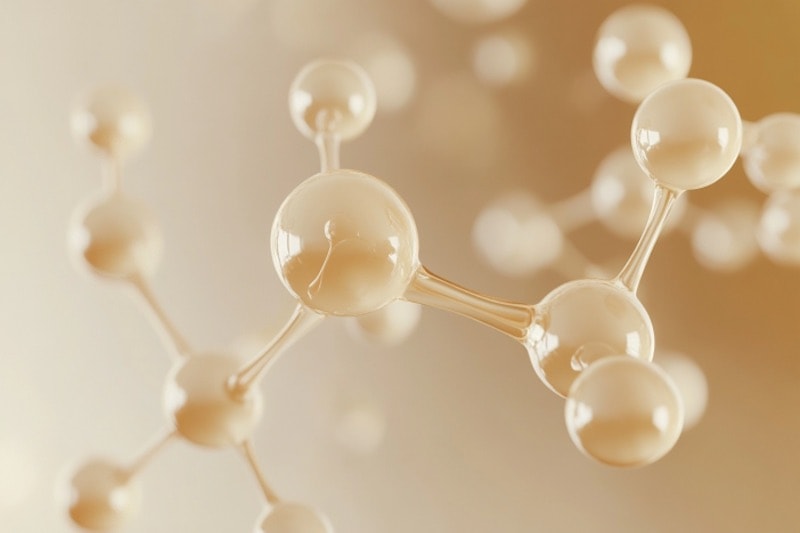
What cosmetics is formaldehyde found in?
-
Nail hardeners, polishes, and removers
-
Hair smoothing treatments
-
Shampoos and conditioners
Even if you know about formaldehyde or formaldehyde-releasing preservatives (FRPs), there’s another layer to consider: hidden formaldehyde. This refers to formaldehyde not intentionally added to products, yet it can still sneak in due to contamination, raw materials, or packaging issues.
Sources of Hidden Formaldehyde
-
Impurities in Raw Materials:
-
A notable study identified dihydroxyacetone (DHA), a common ingredient in self-tanning products, as a potential source of hidden formaldehyde. During storage or under certain conditions, DHA can degrade and release formaldehyde as a byproduct
-
Other raw materials used in cosmetic formulations may also contain trace amounts of formaldehyde due to contamination during manufacturing processes.
-
-
Packaging Interactions:
Packaging materials can contribute to hidden formaldehyde levels. For instance, certain plastic containers may leach formaldehyde into the product over time, especially under conditions of heat or prolonged storage
-
Chemical Reactions During Formulation:
Some chemical reactions that occur during the production or shelf life of cosmetics can inadvertently generate formaldehyde. For example, reactions involving alcohols and aldehydes in the presence of oxidizing agents may lead to trace amounts of formaldehyde formation
A 2024 study tested 142 cosmetic products (none listed formaldehyde releasers on the label) and found that 18% contained hidden formaldehyde—levels ranged from 0.5 to 507 ppm. This is especially concerning for leave-on products like lotions or creams because prolonged contact with the skin can ramp up your chances of irritation or allergies.
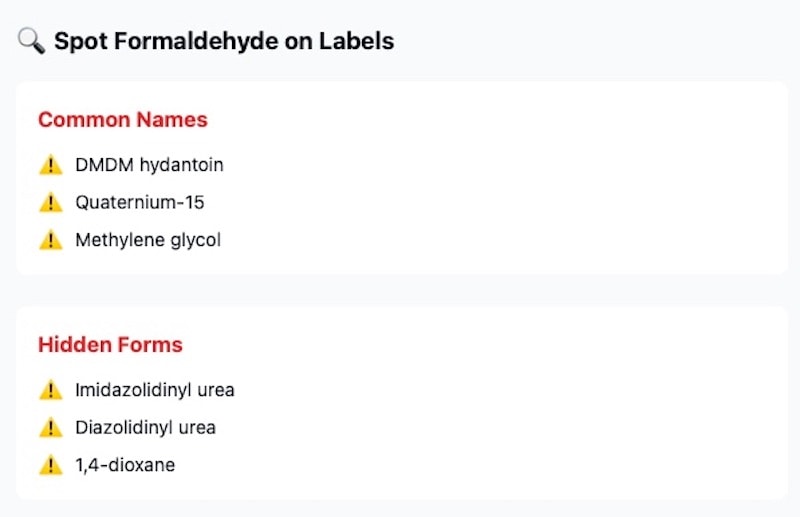
Is Formaldehyde Safe in Cosmetics?
It depends on how much you're exposed to and how sensitive you are to toxic substances - for some, even small amounts can cause irritation. Here's a break down of the potential health risks:
Short-term health concerns:
-
Eye, respiratory and skin irritation
-
Skin barrier damage (especially for those with eczema or sensitive skin)
-
Allergic reactions including skin allergies like irritant contact dermatitis
Longer-term health concerns
-
Carcinogenic Potential: The International Agency for Research on Cancer (IARC) and the National Toxicology Program (NTP) classify formaldehyde as a human carcinogen. A study by the National Cancer Institute involving over 25,000 workers exposed to formaldehyde linked it to nasopharyngeal cancer (6 out of 10 peoplewe in the study were diagnosed).
-
Oxidative Stress and Systemic Impairments:
-
Recent studies have highlighted that formaldehyde exposure induces oxidative stress, a condition where harmful free radicals overwhelm the body's antioxidant defenses. This can lead to cellular damage across various organ systems.
-
Research has also identified systemic health impairments caused by formaldehyde exposure, including neurotoxicity, reproductive toxicity, and pulmonary fibrosis.
-
Formaldehyde exposure has been linked with DNA damage and chromosomal alterations, which may contribute to its carcinogenic effects.
-
-
Neurotoxic Effects:
-
Prolonged exposure to formaldehyde has been associated with neurotoxic effects such as cognitive decline and mood disorders. Studies suggest that oxidative stress plays a key role in these outcomes by damaging neurons and promoting inflammation in the brain.
-
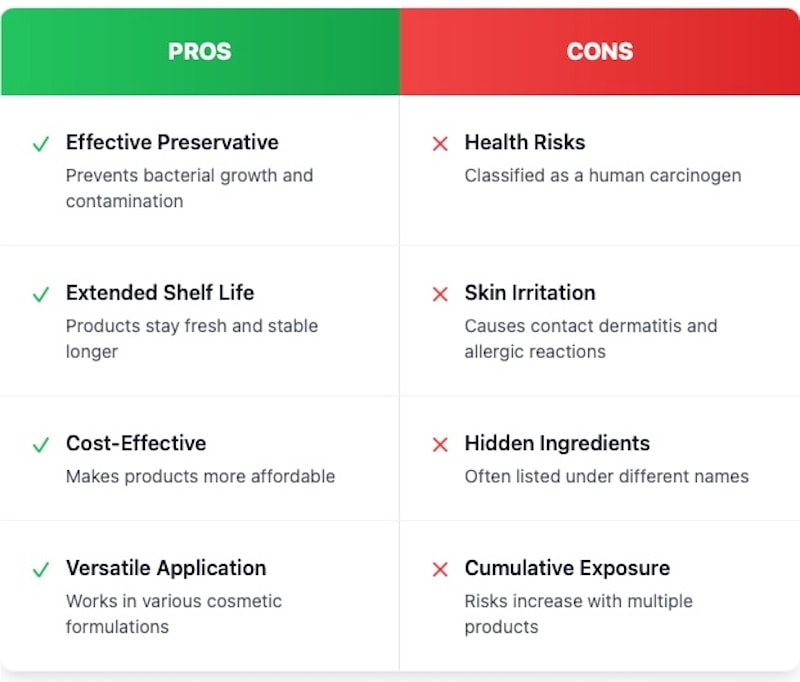
Regulatory Challenges
Current regulations often focus on declared ingredients like FRPs but fail to address hidden sources of formaldehyde. For example:
-
In the EU, formaldehyde is outright banned in cosmetics, and even formaldehyde releasers are tightly regulated (e.g. the formaldehyde releaser DMDM hydantoin is often found in concentrations below 0.05%). Anyway, the EU does not mandate testing for hidden sources unless explicitly suspected.
-
In the US, the FDA doesn't strictly regulate formaldehyde in cosmetics. Companies are not legally required to get FDA approval before selling their products, so the responsibility falls on us as consumers to stay educated.
States like California are leading the way, with laws like the Toxic-Free Cosmetics Act, which will ban formaldehyde from beauty products starting in 2025.
Hopefully, this inspires similar changes worldwide!
What levels of formaldehyde are considered safe?
While cosmetics often contain formaldehyde in concentrations below 0.2% (2,000 ppm), frequent use of multiple products can result in cumulative exposure that exceeds safe thresholds.
Whilst this may seem reassuring, however, think about how many products you use daily - lotions, hair products like shampoos e.g - even small amounts can add up quickly, inevitably increasing your exposure!
This is particularly concerning given that even low levels of formaldehyde can trigger oxidative stress and other systemic effects over time.
Members of the Scientific Committee on Consumer Safety (SCCS) stated that "The present threshold does not sufficiently protect consumer... reducing the present threshold to 0.001% (10 ppm), will protect the vast majority of consumers sensitised to formaldehyde"
Alternatives to Formaldehyde in Cosmetics
As awareness grows about the risks of formaldehyde and formaldehyde-releasing preservatives (FRPs) in cosmetics, the beauty industry has been exploring safer and more innovative alternatives. These alternatives not only reduce health risks but also align with the increasing demand for clean and non-toxic beauty products. Below are some of the most promising options:
Natural preservatives
Nature's got your back!! There are plenty plant-based ingredients that work as preservatives while being gentler on your skin. Look out for:
Phenyoxyethanol
-
Phenoxyethanol: A widely used preservative that is gentle on the skin and effective against bacteria.
-
Sodium Benzoate: Commonly found in natural formulations, it inhibits microbial growth.
-
Potassium Sorbate: Effective against mold and yeast, often used in organic products.
-
Essential Oils: Tea tree oil, rosemary oil, and grapefruit seed extract not only act as natural antimicrobials but also add a lovely herbal scent!
While these options are effective for many formulations, they may have limitations in preserving highly complex or long-shelf-life products.
Cutting-edge technologies
Recent advancements in cosmetic science have introduced cutting-edge solutions that address the limitations of traditional preservatives while maintaining safety and efficacy.
New solutions are being experimented with to keep products fresh without toxic chemicals:
-
Bioengineered Peptides
-
Disrupt bacterial membranes without harming human cells.
-
Biodegradable and eco-friendly.
-
Offer targeted microbial control, so less need for harsh preservatives.
-
-
Antimicrobial Peptides (AMPs)
AMPs are small proteins that occur naturally in many organisms and provide defense against bacteria, fungi, and viruses.-
Occur naturally in many organisms.
-
Effective at low concentrations.
-
Reduce risk of bacterial resistance.
-
Work well in various formulas.
Studies have demonstrated the potential of AMPs such as nisin and defensins for use in personal care products, offering both safety and efficacy.
-
-
Fermented Ingredients
Fermentation-derived ingredients, such as fermented radish root filtrate (Leuconostoc/Radish Root Ferment Filtrate), act as natural antimicrobials. These ingredients:
-
Are derived from probiotics or plant-based sources.
-
Provide broad-spectrum antimicrobial activity.
-
Are suitable for use in clean beauty formulations.
-
-
Microbial Stabilizers
Another emerging trend is the use of microbial stabilizers that maintain product freshness by creating an environment unfavorable for bacterial growth:
-
These stabilizers work by adjusting pH levels or introducing oxygen-scavenging compounds.
-
They are particularly useful in water-based formulations where microbial contamination is more likely.
The shift toward safer preservatives is not just about reducing health risks—it’s also about addressing consumer demand for transparency and sustainability.
-
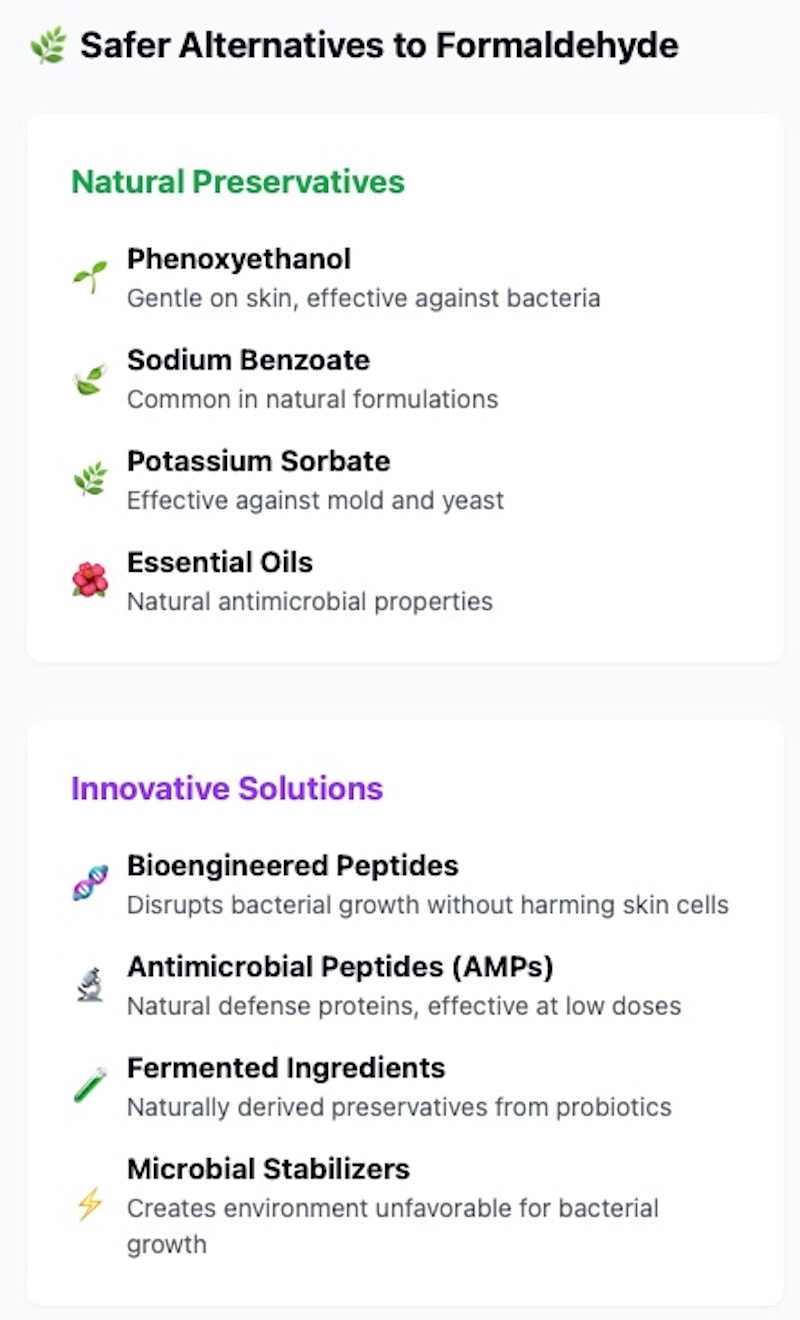
Formaldehyde-free brands
The great news is that some brands have already eliminated formaldehyde and are transparent about it. Look for companies like ILIA beauty*, 100% Pure*, RMS beauty* —or do your own scouting.
You’ll be pleasantly surprised at how many clean brands are out there committed to safer, toxin-free formulations Keep an eye out for packaging that clearly states “formaldehyde-free,” and always check ingredient labels, just in case.
How to spot formaldehyde in your products
Navigating the beauty aisle can be a lot especially when looking for clean beauty, and can be especially harder when trying to avoid ingredients like formaldehyde. Here is a few things you can do to make your life easier:
Read ingredients labels:
-
You'll never see 'formaldehyde listed outright, but you will be able to spot ingredients like DMDM hydantoin, methylene glycol, quaternium-15, 3-dioxane, imidazolidinyl urea and diazolidynl urea!
-
Check labels carefully especially high-risk items like nail polishes, hair straightening treatments, and even baby shampoos!
-
Look for labels that explicitly state "formaldehyde-free" or "preservative-free."
-
Opt for brands that use certified natural or organic preservatives.
-
Check ingredient lists for innovative alternatives like bioengineered peptides or AMPs.
Use Tech to simplify the process:
Apps and databases can save you a lot of time and effort when it comes to reading ingredient lists, some user-friendly options are:
-
Think Dirty App: Scan barcodes and instantly see if a product contains harmful ingredients like formaldehyde, this will also show you other sneaky harmful chemicals like fragrance, PFAS, and other endocrine disruptors too if you are interested
-
Environmental Working Group's (EWG) Skin Deep Database: This database has been so useful for me, it has thousands of product reviews and is great for finding safer alternatives, and to check your favourite products for identifying nasties!
These tools make it easier than ever to shop smarter and safer!
Avoid 'Greenwashing'
Not all products labelled 'natural' or 'organic' or 'clean' are actually safe. You can avoid being mislead by:
-
Looking for trusted certifications: Look for seals like 'EWG verified' or 'USDA organic' or 'toxic-free' these ensure the product has been thoroughly vetted
-
Ignore buzzwords like 'green' and 'eco-friendly', these terms are not regulated and can be marketing fluff!
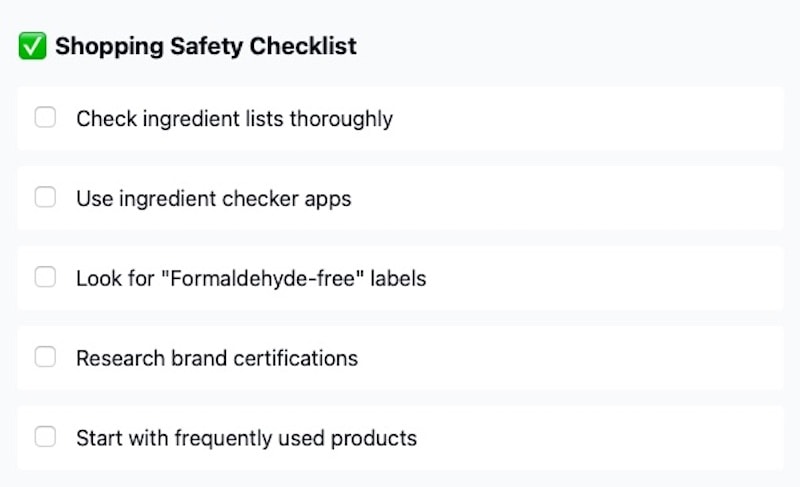
Practical tips for safer choices
Making the switch to cleaner beauty and non-toxic makeup brands doesn't have to be hard, keep things simple by:
-
Master the ingredient list and get familiar with formaldehyde-releasing ingredients - after some practice you will know exactly what to look for!
-
Look for seals and certified products, labels like 'EWG verified' and 'cruelty-free' are great indicators or safe formulations - despite not being directly tied with formaldehyde
-
Patch testing before committing, by applying a small amount to your wrist or behind your ear and leaving it for 24 hours. No irritation? You're good to go!
-
Prioritise frequently-used items, products like body lotions and shampoos that cover large areas of your skin should be the first to be swapped out when looking for formaldehyde-free options.
Further Resources
Your journey toward a safer and healthier cosmetic choices doesn't have to stop here! There are plenty of trusted resources should you wish to stay informed or read more. Here are a few of my favourites:
Campaign for Safe Cosmetics
If you’re eager to keep learning or want some extra backup, here are a few favorite resources:
• Campaign for Safe Cosmetics
An advocacy group aiming to remove harmful chemicals from personal care products. Their website offers consumer guides and updates on legislation—ideal if you’re new to clean beauty and non-toxic living!
• Environmental Working Group’s Skin Deep Database
With detailed safety info on thousands of products, EWG's Skin Deep Database is one of the best ways to pinpoint safer alternatives. Type in an ingredient or product name, and you’ll get an in-depth analysis in seconds.
it is super easy to use, you can search a product or ingredient and it provides a full breakdown of its risks and benefits - if you're serious about switching to non-toxic products, this database will become you're go-to tool!
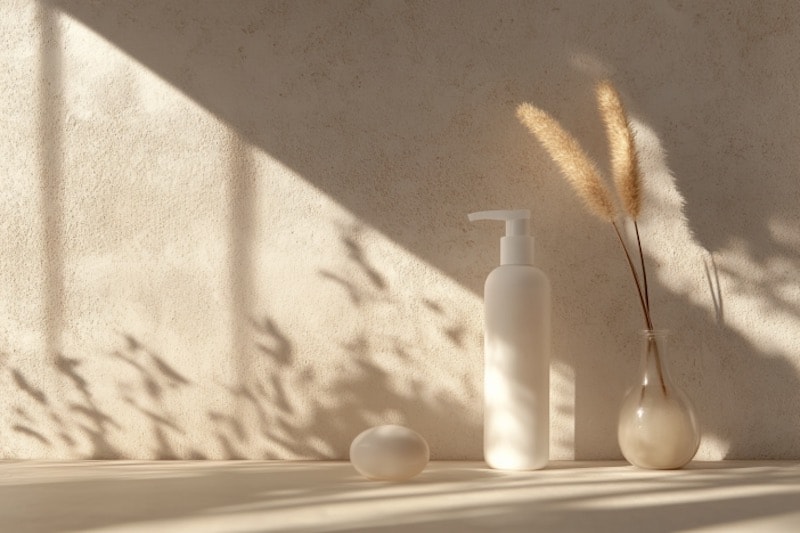
Key Takeaways
-
Formaldehyde is common: About 20% of cosmetic products contain it or related preservatives. Keep an eye on nail polishes, shampoos, and hair straighteners in particular.
-
Health risks: Exposure can irritate skin, trigger allergic reactions, and potentially raise the risk of nasopharyngeal cancer.
-
Regulations vary: The EU bans formaldehyde but still allows trace amounts of formaldehyde-releasing agents; the US is more lenient, and consumers must stay informed.
-
Safer alternatives: Look for natural preservatives like phenoxyethanol, essential oils and brands offering formaldehyde -free products
-
Smart choices: Read labels, use tools like EWG's Skin Deep Database, and prioritise certified, safe products for everyday use
FAQ to Formaldehyde in Cosmetics
Is formaldehyde used in makeup?
Yes, formaldehyde can be found in makeup and other cosmetics, but typically as a byproduct of preservatives known as formaldehyde-releasers. These substances slowly release formaldehyde to prevent microbial growth in products like shampoos, conditioners, and lotions.
Should I avoid formaldehyde?
Yes. Formaldehyde is a known irritant and allergen that can cause contact dermatitis and has been classified as a carcinogen, meaning it may pose long-term health risks with prolonged exposure
What cosmetics is formaldehyde found in?
It’s particularly common in water-based products due to its preservative properties. Formaldehyde or its releasers are often found in personal care products such as shampoos, conditioners, body washes, nail polishes, and some leave-on cosmetics.
Is formaldehyde bad for your skin?
Yes, formaldehyde can be harmful to the skin. It is a common allergen that may cause irritation or allergic contact dermatitis, especially in individuals with sensitivities. Prolonged exposure to high levels of formaldehyde has also been linked to more severe health concerns













